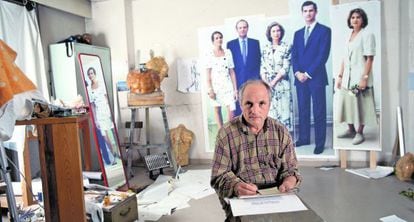The painter still fighting to finish a Spanish royal portrait, 20 years on
Artist Antonio López says he is close to completing his painting of the king and his family

Twenty years after accepting a commission to paint a portrait of the royal family, Antonio López finally feels ready to announce a completion date: October 2014.
The fact that King Juan Carlos recently announced that he is abdicating the throne does not seem to bother the 78-year-old artist – famous for his hyperrealistic style and slow, painstaking working methods – or put undue pressure on him to finish his work.
“I go to the Royal Palace every day of the week, from 12 to 5, without a lunch break,” he explains. “I do what I can, given the difficulties of dealing with a commission. The hard part was not developing an aversion to it.”
It doesn’t matter that the painting does not show the new royal family”
Although the upcoming coronation of the crown prince will result in a royal shuffle – Felipe VI will be the new king, Letizia the queen consort, and Felipe’s sisters Elena and Cristina will no longer be part of the royal family proper – the painting will depict Juan Carlos and Sofía and their three children, Elena, Felipe and Cristina, all looking considerably younger.
“It doesn’t matter that the situation has changed and that the painting does not show the new royal family. Mine is the portrait of a Spanish family, and that is the way I conceived it from the moment they asked me to paint it,” he explains.
López, who was the subject of an award-winning movie, El sol del membrillo, directed by Víctor Erice that documented his difficulty painting a quince tree in his backyard, admits that he has sometimes gotten stuck with the project as he is not used to working from photographs of his subject matter.
I’m not surprised the king is tired because he’s been working around the clock”
“I knew I could not get back to them easily to work on a detail of their faces or a movement of their bodies,” he explains. “It took me a while to figure out where each of them would stand. I would bring them closer, push them back. It was hard to find the exact spot on a canvas this size [3.40 meters long and three meters high].
López would not say whether he will turn in what some might consider an “unfinished” painting in the conventional sense of the word, as he has done with much of his work.
“It is hard to say when a painting is finished. I don’t know very well. Jan Van Eyck and Velázquez did not add the finishing touches,” he explains. “There are always abandoned areas that can be occupied or left empty.”
The 78-year-old artist is famous for his hyperrealistic style and slow, painstaking working methods
While he chipped away at the portrait, López worked on many other projects, including his famous views of Madrid’s Gran Vía.
“Nobody seems to want to recognize the difficulties of this painting,” he says. “I generally do not accept commissions. What’s more, modern artists do not work this way. The painter decides what to paint. I made an exception for the portrait and sculpture of the royals for Valladolid. The latter was turned in, the painting not yet. But let me tell you that it will be included in the October exhibition that National Heritage is preparing with its holdings.”
Despite the 20-year struggle, there are no regrets. López recalls that the king and queen came around to the studio once, but the canvas was covered and they did not ask to see it. “I was grateful for that,” he recalls.
López adds that he is not very surprised at Juan Carlos’ decision to relinquish the throne. “He is an older man, like myself, with his ailments. He has worked a lot, and well. I’m not surprised that he is tired because he’s been working around the clock.”
Asked whether he would accept a commission by the family of Felipe VI, López says that he might.
“As long as you don’t betray your way of painting, there is nothing wrong in accepting. The main thing is for the artist to be in control of his work. In the recent history of Spanish art there are not many important commissions, but let’s not forget that Guernica was commissioned by the Spanish Republic. The portrait of the royals has ended up becoming an excellent laboratory for me.”










































